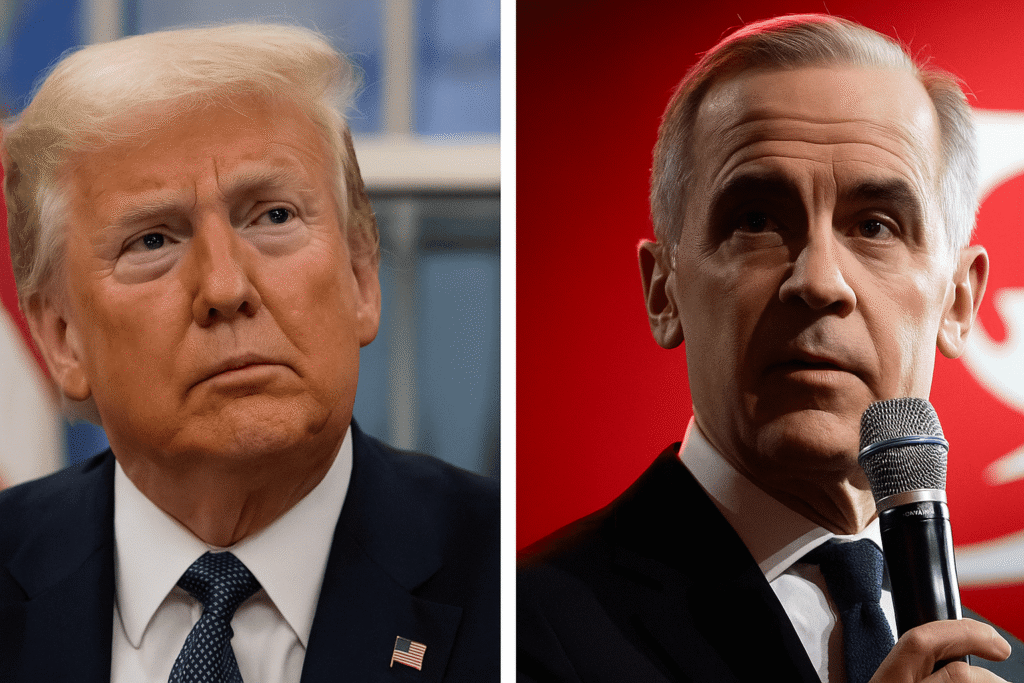The US Canada trade war 2025 has officially entered a volatile new phase. In a bold move, shaking global markets and straining long-standing alliances, U.S. President Donald Trump signed an executive order that raises tariffs on Canadian goods from 25% to 35%. The move targets imports not covered under the USMCA, triggering outrage from Canadian leaders and economic anxiety across North America.
From lumber and aluminum to agricultural exports, the new trade barrier hits billions in cross-border commerce. President Trump’s administration cited national security concerns and Canada’s recognition of a Palestinian state as core justifications, sparking debate over the real motives behind this latest confrontation in the intensifying US Canada trade relations.
Canada Slams Tariffs, Prepares for Retaliation
Canadian Prime Minister Mark Carney wasted no time responding. “This action is a blunt economic weapon, not a strategic negotiation,” he declared at a press briefing in Ottawa. “Canada will not stand by while our industries, workers, and sovereignty come under threat.”
In response to the Trump Canada tariffs, Carney announced a set of retaliatory policies, including increased duties on U.S. steel and aluminum. The government is also preparing a broader package targeting U.S. agricultural products, tech imports, and automobile parts.
Ontario Premier Doug Ford joined the national chorus, urging the federal government to impose a reciprocal 50% duty on strategic U.S. exports. “These tariffs are nothing less than economic warfare,” he said. “Canada must respond swiftly and decisively.”
This marked shift has placed Canada retaliatory tariffs at the forefront of diplomatic discussions. Policy analysts believe Canada will also explore trade expansion with the European Union and Asia to offset rising dependency on U.S. markets, further aggravating the already-tense USMCA tensions.
Global Markets Rattle as Confidence Wanes
The announcement of the 35% tariff sent immediate shockwaves through global financial systems. Stock markets in Europe and Asia posted deep losses, and currency fluctuations rippled through international exchanges. Economic observers warn that the 2025 trade war news could lead to supply chain disruptions, especially in sensitive industries such as automotive manufacturing, agriculture, and energy.
U.S. exporters have expressed growing concern. “We rely on the Canadian market to survive,” said Alex Johnson, CEO of a Michigan-based farm equipment manufacturer. “These tariffs are going to hurt American jobs just as much as Canadian ones.”
The risk of prolonged hostilities also threatens the credibility of the USMCA, the regional trade pact once hailed as a new era of cooperation. With mounting Canadian export restrictions already in motion, experts fear the treaty could become functionally obsolete if both sides continue to escalate.
Why the US Canada Trade War 2025 Is Different

Unlike previous trade spats, the US Canada trade war 2025 appears fueled more by political signaling than economic rationale. The Trump administration has framed the move as protecting national security and defending American industry. But critics argue the strategy reflects election-year posturing and diplomatic retaliation disguised as trade policy.
“This isn’t about economics. It’s about optics,” said Maria Gutierrez, a senior trade analyst at the Brookings Institution. “Weaponizing trade weakens alliances and reduces predictability in international relations.”
Still, Trump’s supporters claim the tariff hike is long overdue. “Canada has taken advantage of the U.S. for decades,” said Senator Josh Hawley. “This action corrects years of imbalance and sends a strong message that the U.S. will no longer be passive.”
With the new policy affecting hundreds of billions in goods, the real-world consequences are expected to intensify as the tariffs take effect on August 7, 2025. Unless both nations return to the negotiation table, the economic damage could spill into 2026 and beyond.
What’s Next: Can Diplomacy Prevail?
There’s still a narrow window for compromise. Canada has indicated a willingness to enter talks but insists that any resolution must include a full rollback of the 35% tariff. Meanwhile, the White House has shown no public signs of softening its position.
“This isn’t about backing down,” said White House Trade Representative Linda Baines. “We will hold our trading partners accountable Canada included.”
As both sides dig in, the international community watches closely. Key allies in Europe and Asia have already begun reevaluating trade routes, fearing secondary effects from the fallout. Investors remain jittery, and businesses are bracing for another year of uncertainty.
The US Canada trade war 2025 is more than a bilateral dispute it’s a defining moment in the evolution of global economic diplomacy. Whether it ends in dialogue or deepened division, the outcome will shape North American trade for years to come.
